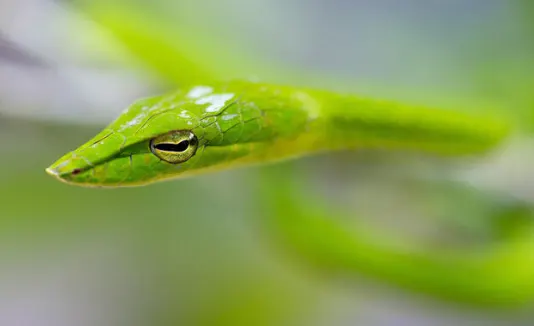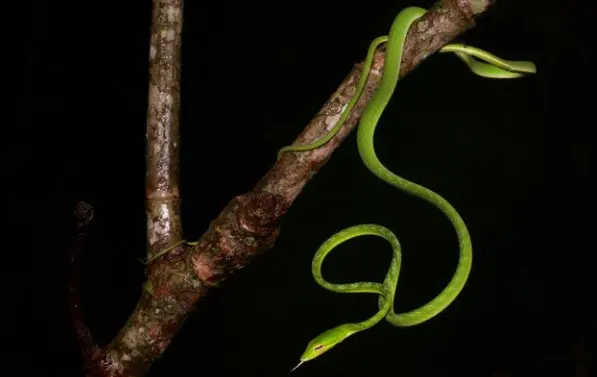The Asian vine snake, scientifically known as Ahaetulla prasina, is a captivating species native to Southeast Asia. This slender, bright green snake is notable for its pencil-thin body and unique hunting techniques, making it an interesting subject of study for herpetologists and nature enthusiasts alike.
Table of Contents
Scientific Classification and Names
The Asian vine snake belongs to the kingdom Animalia, phylum Chordata, class Reptilia, order Squamata, family Colubridae, and genus Ahaetulla. The specific epithet prasina translates to “leek green” in Latin, aptly describing the snake’s vibrant coloration. This species is also known by several common names, including Gunther’s whip snake, Oriental whip snake, Boie’s whip snake, and Jade vine snake.

Conservation Status
Despite its mesmerizing appearance and interesting behavior, the Asian vine snake is classified as “Least Concern” by conservationists. Its population is stable, and it is widespread across its native regions in Southeast Asia, including the Philippines, Thailand, Vietnam, Cambodia, and Myanmar.
Physical Characteristics
One of the most distinctive features of the Asian vine snake is its bright green scales, which can sometimes appear fluorescent. Some individuals also display a yellow stripe along their back or a pattern of blue lines through their scales. The snake’s head is spear-shaped, with a pointed tip and noticeable bumps on either side housing its venom glands. Another fascinating trait is its vertical black pupils set in yellow eyes, distinguishing it from the round-pupiled green vine snake found in Central and South America.
Asian vine snakes typically measure between 2.5 to 5 feet in length, with a body as thin as a pencil. This slender build aids in their camouflage among the branches and vines of their forest habitats.
Behavior and Hunting Techniques
Asian vine snakes are known for their mild temperament towards humans but exhibit more assertive behavior when hunting prey. They primarily feed on frogs, lizards, insects, and occasionally small birds. The snake’s narrow body and bright green coloration allow it to blend seamlessly with tree branches, making it a stealthy predator. These snakes have a unique hunting strategy where they use their long, thin tongue to mimic a worm, luring unsuspecting frogs or lizards within striking distance. Once close enough, the snake strikes quickly, injecting venom through its rear fangs and often chewing on its prey to release more venom.
Reproduction and Lifespan
Asian vine snakes reach sexual maturity at around three years of age. Breeding typically occurs in late spring or early summer, with males sometimes engaging in combat over a female. These snakes are ovoviviparous, meaning they give birth to live young rather than laying eggs. A female can give birth to up to 12 neonates, each measuring approximately 9.5 inches in length. In the wild, these snakes can live up to 12 years, while in captivity, their lifespan ranges from 8 to 12 years.
Habitat and Adaptations
Asian vine snakes inhabit the moist and dry forests, as well as shrubland areas of Southeast Asia. They thrive in tropical climates and are active year-round. These snakes are primarily arboreal, spending most of their time in trees where their green coloration provides excellent camouflage. They have evolved several adaptations to their environment, including lighter coloration to reflect heat and thicker skin to retain moisture.
Threats and Predators
Despite their stable population, Asian vine snakes face threats from human activities, particularly in regions where they are hunted for traditional medicines and snake wine. Additionally, they are captured and sold in the pet trade. Natural predators include birds of prey, larger snakes, and certain mammal species.
Human Interaction and Pet Trade
Though mildly venomous, the venom of the Asian vine snake is not considered dangerous to humans, which is why some people keep them as pets. However, these snakes require specialized care, including a diet that often includes amphibians, which can make them challenging to keep in captivity. Bites from these snakes should be treated by cleaning the wound, applying first-aid ointment, and monitoring for signs of infection.

7 Interesting Facts About the Asian Vine Snake
- Unique Venom Delivery: Unlike many venomous snakes that inject venom through front-facing fangs, the Asian vine snake has grooved fangs located at the back of its mouth. This unique adaptation requires the snake to chew on its prey to effectively deliver venom.
- Coloration and Camouflage: The bright green coloration of the Asian vine snake helps it blend seamlessly into its forest habitat, making it nearly invisible among the foliage. This camouflage is essential for both hunting and avoiding predators.
- Prehensile Tail: The Asian vine snake has a prehensile tail, which allows it to grasp and maneuver through branches and vines with ease. This adaptation is particularly useful for an arboreal lifestyle, providing stability and support as it navigates its environment.
- Daytime Hunter: Unlike many snakes that are nocturnal hunters, the Asian vine snake is active during the day. This diurnal behavior reduces competition with other predators and allows it to exploit a different niche in its ecosystem.
- Diet Variety: While frogs are a primary
food source, the Asian vine snake’s diet also includes lizards, insects, and occasionally small birds. Its narrow, elongated body and sharp vision make it an efficient hunter of various prey. - Reproduction: Asian vine snakes are ovoviviparous, meaning the females give birth to live young rather than laying eggs. A single female can give birth to as many as 12 neonates at a time, ensuring the next generation has a strong start.
- Mild Venom: Although the Asian vine snake is venomous, its venom is considered mild and not harmful to humans. This has led to some individuals keeping them as exotic pets, although specialized care is required to maintain their health and well-being.
The Asian vine snake is a remarkable species with its striking appearance, unique hunting methods, and fascinating adaptations to its environment. While not considered endangered, conservation efforts and responsible pet ownership are essential to ensure their continued presence in the wild. Their presence in the lush forests of Southeast Asia continues to intrigue and educate those fortunate enough to encounter them.
- Enchi Ball Python: A Unique and Stunning Morph of Python regius - March 27, 2025
- Emerald Tree Monitor: The Enigmatic Green Guardian of the Rainforest - March 26, 2025
- The Egyptian Cobra (Naja haje): A Fascinating Serpent - March 25, 2025
